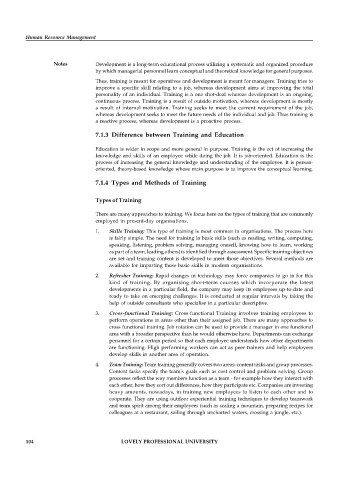Page 111 - DMGT406_HUMAN_RESOURCE_MANAGEMENT
P. 111
Human Resource Management
Notes Development is a long-term educational process utilizing a systematic and organized procedure
by which managerial personnel learn conceptual and theoretical knowledge for general purposes.
Thus, training is meant for operatives and development is meant for managers. Training tries to
improve a specific skill relating to a job, whereas development aims at improving the total
personality of an individual. Training is a one shot-deal whereas development is an ongoing,
continuous process. Training is a result of outside motivation, whereas development is mostly
a result of internal motivation. Training seeks to meet the current requirement of the job,
whereas development seeks to meet the future needs of the individual and job. Thus training is
a reactive process, whereas development is a proactive process.
7.1.3 Difference between Training and Education
Education is wider in scope and more general in purpose. Training is the act of increasing the
knowledge and skills of an employee while doing the job. It is job-oriented. Education is the
process of increasing the general knowledge and understanding of the employee. It is person-
oriented, theory-based knowledge whose main purpose is to improve the conceptual learning.
7.1.4 Types and Methods of Training
Types of Training
There are many approaches to training. We focus here on the types of training that are commonly
employed in present-day organisations.
1. Skills Training: This type of training is most common in organisations. The process here
is fairly simple. The need for training in basic skills (such as reading, writing, computing,
speaking, listening, problem solving, managing oneself, knowing how to learn, working
as part of a team, leading others) is identified through assessment. Specific training objectives
are set and training content is developed to meet those objectives. Several methods are
available for imparting these basic skills in modern organisations.
2. Refresher Training: Rapid changes in technology may force companies to go in for this
kind of training. By organising short-term courses which incorporate the latest
developments in a particular field, the company may keep its employees up-to-date and
ready to take on emerging challenges. It is conducted at regular intervals by taking the
help of outside consultants who specialise in a particular descriptive.
3. Cross-functional Training: Cross-functional Training involves training employees to
perform operations in areas other than their assigned job. There are many approaches to
cross functional training. Job rotation can be used to provide a manager in one functional
area with a broader perspective than he would otherwise have. Departments can exchange
personnel for a certain period so that each employee understands how other departments
are functioning. High performing workers can act as peer trainers and help employees
develop skills in another area of operation.
4. Team Training: Team training generally covers two areas: content tasks and group processes.
Content tasks specify the team's goals such as cost control and problem solving. Group
processes reflect the way members function as a team - for example how they interact with
each other, how they sort out differences, how they participate etc. Companies are investing
heavy amounts, nowadays, in training new employees to listen to each other and to
cooperate. They are using outdoor experiential training techniques to develop teamwork
and team spirit among their employees (such as scaling a mountain, preparing recipes for
colleagues at a restaurant, sailing through uncharted waters, crossing a jungle, etc.).
104 LOVELY PROFESSIONAL UNIVERSITY

